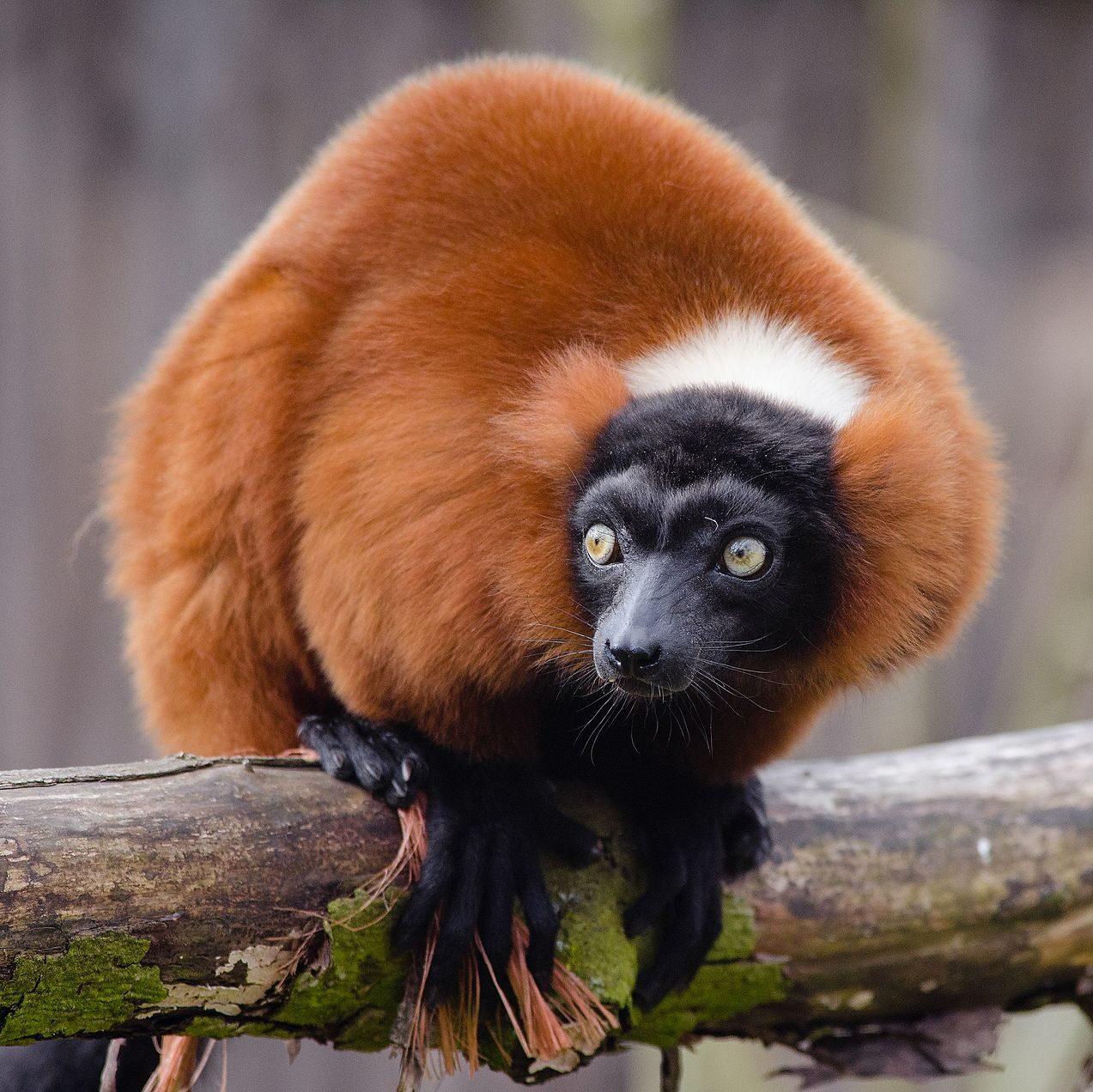You’re about to meet one of the cutest creatures on the planet: the red ruffed lemur. Native to the forests of Madagascar, those lovely primates appear to be a cross between a fox, a squirrel, and a teddy bear. If you’re ready for some serious cuteness overload, read on. We’ll discover these furry pals, including what makes them so special with their reddish fur and fluffy white ruffs. You’ll learn about their habitat, own family groups, diet, behaviors, and why they’re endangered. Get your camera ready, because your heart will soften whilst you see pics of the infants clinging to their mothers. The red ruffed lemur has already won over the island locals with its lovely nature. Now it’s your turn to fall in love!
Also check Ecology of Black Lemur: Dark Fur, Bright Soul
An Introduction to the Red Ruffed Lemur
Native to the tropical island of Madagascar, the red ruffed lemur is one of the country’s most charismatic creatures. With its lush chestnut red fur, hanging white ruff, and black and white facial markings, you cannot help but fall in love with this primate at the first sight.
Red ruffed lemurs are unique among lemurs in that they are highly arboreal, spending up to ninety percent in their time high up inside the trees. With lengthy limbs and strong gripping fingers and toes, they leap effortlessly from branch to branch, often making gravity-defying aerial acrobatics look smooth. While agile, they move slowly and deliberately while foraging.
| Feature | Details |
|---|---|
| Scientific Name | Varecia rubra |
| Habitat | Madagascar, primarily in the northeastern rainforests |
| Diet | Mainly fruits, nectar, flowers, and leaves, but also eats seeds, insects, and small vertebrates |
| Social Structure | Diurnal and arboreal, living in small groups of 2-16 individuals, typically with a dominant female |
| Conservation Status | Critically Endangered (IUCN Red List), facing threats from habitat loss and hunting |
These primates live in near-knit circle of family groups of 2 to 15 individuals, led by way by a breeding pair. They are very social and communicate with a extensive range of vocalizations and scent markings. Grooming and playing with each other strengthens social bonds. Males and females regularly duet with synchronized vocalizations to establish territories and appeal to mate with partners.
Red ruffed lemurs have a very specialized diet, feeding almost exclusively on the nectar, pollen, and fruit of just a few tree species native to Madagascar’s eastern rainforests. This restricted diet makes them prone to habitat loss and climate change. Their number has decreased over 50% in recent decades as deforestation shrinks their last remaining forest homes.

Can Red Ruffed Lemur be your pet?
Red ruffed lemurs may be one of the cutest primates around, but should you consider having one as a pet? The short answer is no. Here’s why:
- Red ruffed lemurs are classified as endangered in the wild. Taking one from Madagascar to be a pet contributes to the threat against the species. Their population has declined over 50% in recent decades due to habitat loss and hunting.
- It’s illegal to own a red ruffed lemur as a pet in most places, including the United States. These primates are protected under international wildlife treaties like CITES. You may be fined or face other legal consequences for owning one.
- Lemurs have very specific dietary requirements to stay healthy that are challenging to meet properly in captivity outside of an accredited zoo. Feeding them an improper diet can lead to painful health issues over time.
- They need specialized veterinary care from exotic animal vets, which can be difficult to access and very expensive. Most normal vets are not qualified to treat lemurs.
- Lemurs are highly active and agile animals that need ample space to move around. It’s difficult to provide proper housing for them as a private owner. They also need environmental enrichment through toys, social interaction, etc.
So while their expressive eyes and playful antics may tempt you, a red ruffed lemur does not make a good pet. The best way to safely enjoy their charm is to visit them at an AZA-accredited zoo or sanctuary. There, you’ll be contributing to the conservation of the species as well

The Red Ruffed Lemur’s Habitat and Behaviors
The red ruffed lemur is native to the tropical rainforests of eastern Madagascar. They mainly live high in the forest canopy, but will occasionally descend to the forest floor.
An Arboreal Lifestyle
As tree dwellers, red ruffed lemurs are perfectly adapted to living in the treetops. Their long limbs and grasping hands and feet allow them to easily move through the branches. Their long tails help them balance as well. You’ll often see them leaping gracefully from tree to tree.
Red ruffed lemurs prefer primary rainforest habitat with tall, mature trees. This provides more abundant fruit and safe sleeping sites. However, deforestation has destroyed much of their natural range. Some troops have adapted to living in secondary forest.
Social Structure
Red ruffed lemurs live in social groups averaging around 15-20 individuals. The core is generally an extended family unit with a breeding pair and their offspring. Related females often stay with the family troop their whole lives.
Males, on the other hand, tend to leave the natal group once they reach maturity. They may transfer between troops or live solitary lives. Dominant males gain breeding rights through battles that involve a lot of noise and visual displays.
Foraging and Feeding
As frugivores, the majority of a red ruffed lemur’s diet consists of fruit and nectar. They supplement this with leaves, seeds, tree bark, spiders, caterpillars and the occasional small vertebrate. Lemurs locate fruit by scent and color vision better adapted to blue hues.
Red ruffed lemurs are important seed dispersers. As they feed, seeds pass through their digestive tracts and are then scattered throughout the forest in their droppings. This helps regenerate their delicate rainforest ecosystem.
The red ruffed lemur’s habitat and behaviors reveal an ancient primate uniquely adapted to its arboreal niche in the forests of Madagascar. Sadly, these delightful animals are critically endangered due to habitat loss. Ecotourism and forest conservation efforts provide hope for their future.
Threats Facing the Red Ruffed Lemur and Conservation Efforts
Unfortunately, the magnificent red ruffed lemur faces serious threats in the wild. Madagascar’s forests, the only place these primates are found, are being destroyed at an alarming rate due to:
- Deforestation from illegal logging operations and slash-and-burn agriculture
- Mining activities
- Charcoal production
- Cattle grazing
As their habitat vanishes, the lemurs are pushed into smaller, fragmented areas where they struggle to survive. Their populations have declined over 50% in recent decades. Red ruffed lemurs are now classified as Critically Endangered by the IUCN Red List.
Several conservation groups are working hard to protect these enchanting animals from extinction:
- The Madagascar Fauna and Flora Group manages protected areas and reintroduction programs.
- The Duke Lemur Center educates people about lemurs to build awareness and support.
- Local communities are being taught sustainable farming techniques that prevent further forest destruction.
You can help too! Support organizations doing on-the-ground lemur conservation work in Madagascar. Spread awareness on social media.
Make wise consumer choices that don’t contribute to deforestation. With determination and compassion, we can ensure the playful red ruffed lemur continues to leap through Madagascar’s canopy for generations to come.

Conclusion
Well, there you have it – the regal red ruffed lemur in all its furry glory! As you can see, this primate native to Madagascar is truly a special creature, known for that fabulous ruff of fur that encircles its face. Hopefully you now feel as passionately as I do about ensuring these adorable animals continue to thrive. Though their numbers are small, focused conservation efforts give hope. Who knows, maybe someday your travels will take you to Madagascar where you’ll spot one of these striking red lemurs high up in the treetops, munching on fruit or leaping with acrobatic grace. If you do, consider yourself privileged to witness an exotic beauty that epitomizes this island’s marvelous biodiversity.
You can also visit https://www.britannica.com/animal/lemur-primate-suborder


This piece was both insightful and entertaining! For additional info, visit: FIND OUT MORE. What do others think?